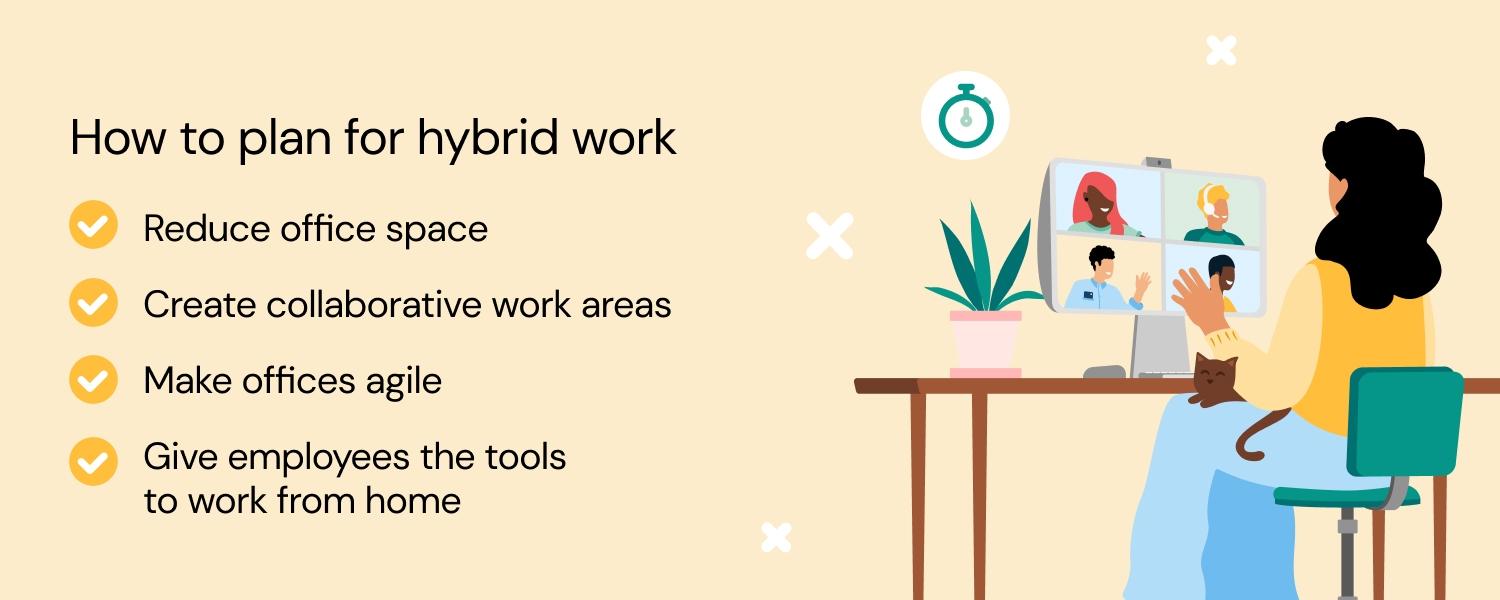Insights
Hybrid work essentials: Everything you need to do it right

Insights

Hybrid work — a mix of both in-person and remote work could be the future. Why? Because it combines the best of both worlds. Sixty-three percent of high-revenue growth companies recognize the value of hybrid work since it increases employee productivity by providing the flexibility to work where it’s best for them.
Offering hybrid work is also becoming increasingly important because it can attract the best talent. More than one-third (35%) say they’d resign if working from home was no longer an option.
Wondering what it takes to make a successful hybrid work model?
Read on to learn everything you need to know.
Traditional offices aren’t going away, but they’re no longer the one and only place people can work. There’s now a second workplace, our homes, or anywhere we can work remotely, for that matter.
For a hybrid or blended model to succeed, it’s vital to consider a few key questions:

Here are a few tips on tackling these challenges and getting the most out of a hybrid workplace:
People will spend time working on-site and off-site. As a result, many businesses move to smaller office spaces to save money on infrastructure, utility, and maintenance.
Another option is to have a flexible office space — part owned and part rented. This way, as the number of employees coming into the office goes up or down, you can easily handle the changes. Flexible office spaces are popping up everywhere, with 86% of companies in 2020 planning on making the switch.
A recent study shows more than two-thirds of remote workers felt disconnected from their colleagues. Connecting with people is one of the many reasons hybrid work is so popular, so it’s critical to create spaces where people can work together.
Research also suggests unstructured collaboration outside formal meetings is key to having a successful business. Offices should be designed for collaborative work like brainstorming sessions — not old-fashioned cubicles or rows of desks monitored by bosses.
The office of the future will need to be flexible as needs will vary from one day to the next. Mobile, multipurpose furniture plus formal and informal areas for collaboration should do the trick. If anyone needs time to focus or more privacy, adjust movable partitions or move to a designated quiet zone.
1 in 10 employees has an unreliable internet connection, partly because their employers don’t contribute to remote work expenses — 46% say this!
Here’s a tip for keeping productivity high in hybrid work: Check access to platforms — do all employees have what they need? If not, consider buying or renting tools, infrastructure, and digital security to use in the office, at home, or on the go.
With a hybrid work model, you’ve got a second workplace — a virtual one. When your business operations take place online, you need the right tools and technology to make everything work. Did you know there’s been a massive rise in global organizations using hybrid cloud technologies? In 2020, the hybrid cloud market was worth USD 56 billion!
Even though employees go back and forth between physical and remote work, it doesn’t mean business operations can’t flow smoothly. With the right technology, you can avoid disruptions and support switching seamlessly between the two.
With the correct tools, you can better connect physical and online offices — promoting communication, collaboration, and productivity in the digital environment.
Check out our top tech tips for running a trouble-free hybrid workplace:
UCaaS brings all forms of communication together. From messaging to audio and video conferences, it’s the key to a successful hybrid workplace. UCaaS lets your team get in touch at any place, any time, and using any device at the click of a button.
Even if there are physical boundaries, UCaaS can knock them down and boost team productivity. 70% of employees saw improved collaboration in their workplace with UCaaS!
Apps can help schedule tasks, people, and timeframes to combine individual flexibility and keep departments running smoothly. Because they record information in one place, apps can help employees make the most of their on-site days, and teams can collaborate smoothly.
Use IoT sensors to track how many people are on-site at any given time. This can help with any occupancy level issues and if the building needs to be evacuated in an emergency.
If fewer employees are working on-site, how can you optimize the space? Hot-desking — allocating desks and rooms to people on an as-needed basis will be your new best friend because it can reduce office operation costs by 30%.
With the help of AI, you can automate hot-desking and make it even more efficient. Self-service workplace apps can let employees book a desk or meeting room and even help customize the workplace to suit their needs.

Workplace culture is vital, especially with 40% of employees considering leaving their jobs this year. Also, 83% of workers prefer hybrid work, so don’t ignore it!
Making sure employees feel a valued part of a team is more important than ever. But how do you promote a positive company culture with some employees working off-site?
Review current practices, consider the needs of every remote worker, and build hybrid work into long-term plans.
Here’s our breakdown of how to eliminate the physical distance and build a sense of community in the hybrid workplace:
Hybrid work accommodates the 67% of remote workers who want more face time with their colleagues, plus it allows people to effectively work from home.
The critical question is: How do you promote more spontaneous conversations online? UCaaS platforms make online communication easy; they help break down silos by encouraging engagement and collaboration. UCaaS also offers more opportunities to stay connected and share social moments with each other. And, as your team shifts to hybrid work, UCaaS gives you the tools to build a sense of community, even when working remotely.
Remote workers shouldn’t feel out of the loop or behind on information. When information is shared far and wide, it helps keep everyone on the same page, allowing your company to ace hybrid work.
Information can be shared through an online newsletter, a company intranet, a shared drive, or other digital platforms. A collaboration platform can also have a built-in newsfeed to help all employees keep up to date.
When you see some employees face-to-face and others work remotely, don’t forget the off-site team members want to feel appreciated too! 76% of employees would consider changing jobs if they don’t feel valued.
Praise should go beyond the office environment. With platforms like Teams, it’s easy to give encouragement online. And when we take the time to do this, it shows a commitment to everyone.
According to a Dynamic Signal study, 80% of the U.S. workforce reports feeling stressed because of ineffective company communication. And, as you probably guessed by now, in a hybrid environment, communication is crucial.
Engaging with employees helps create a more personal workplace, so always include remote employees in meetings and office activities. And be available via an online communication platform whenever needed.
If you haven’t realized by now, the right communication plan and technology are vital to support a successful hybrid workplace.
Your business can be a well-oiled machine with the right technology to improve and automate processes. And you can use digital communication channels to promote work culture and ensure remote employees are engaged.
Sinch can help with all the above. We specialize in remote work solutions and infrastructure to help you put the right cloud solution in place and optimize your business communications.
Our fully integrated collaboration solutions can help your hybrid workplace experience next-level productivity and customer satisfaction.
Are you looking for a communication service to help your employees smoothly collaborate and communicate? Talk to our hybrid workplace experts today to get started.